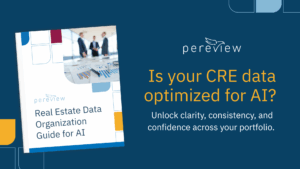What happens when the lifecycle of a real estate asset becomes wobbly? Inefficiency, risk, and headcount go up and reporting becomes painful. The solution: get your data out of spreadsheets and into a software platform that manages the entire Life of the Asset.
If you’ve spent any time working in the real estate industry – or if you’ve ever purchased property – “Life of the Asset” (LOTA) is a phrase you’re familiar with. It’s shorthand for a very complex process involving lots of staff and critical resources. For some commercial real estate firms, the term represents some serious headaches related to efficiency and risk.
By automating the management and reporting process, and selecting the right software to manage your asset(s), you can relieve these headaches. But before we discuss the solution, let’s get a baseline definition of what we mean by LOTA, and what happens when a stage within the lifecycle experiences hiccups.
Defining Life of the Asset
At Pereview, we recognize seven stages within the lifecycle of a real estate asset:
- Acquisition
- Underwriting
- Financing
- Closing
- Asset Management
- Fund/Portfolio Management
- Disposition
As with any lifecycle, these stages occur in a predetermined order, and what happens in a given stage impacts the subsequent stages.
When the cycle gets out of sync
Remember the game “Telephone”? Someone thinks of a phrase, whispers it to the person next to them, and so on until it makes it back to the originator. Inevitably, someone mishears what’s whispered to them and passes that mistake on to the person next to them. By the time it comes full circle, the phrase hardly resembles its original version.
A similar phenomenon can occur within the lifecycle of an asset. If an underwriter makes an error, and that error gets passed down to the financing staff, and they unwittingly hand off corrupted data to the portfolio managers, and so forth. The team at Saxony Partners sees this frequently.
Software exacerbates the issue. Three-quarters of commercial real estate companies are relying on Excel or another spreadsheet software as their primary asset database. While Excel is a great modeling tool, it’s a poor database. Information stored in spreadsheets is rarely integrated with the rest of the firm; it ends up siloed in Excel or a deal pipeline system.
When a stage in the lifecycle gets wobbly, bad things happen to firms.
Increased risk: If dirty data is injected into the LOTA, it can increase reputational risk, operational risk, or both. Reputational risk increases when you report bad data to, say, shareholders, or the government. Operational risk increases as more and more staff are looped into proprietary, siloed processes. If a critical data trove is siloed within the underwriting team and a key member of that team quits, that leads to trouble.
Reporting, headcount headaches: Siloed data decreases efficiency, and decreased efficiency within the context of LOTA shows up in the reporting process. Monthly and quarterly reporting with dirty data is painful, requiring lots of staff and countless key stokes.
Investors are demanding quicker turnaround in reporting cycles, both in standard reporting and ad-hoc needs. These reports are often generated in Excel and either posted to a shared drive or an investor portal. More savvy investment firms have automated some of the reporting to the investor, but there is significant legwork behind the scenes to provide this transparency.
Firms hire more staff to manage demand created by dirty data and manual reporting. It’s why headcount and assets under management tend to increase proportionally. This is inefficient from a personnel standpoint and negatively impacts the firm’s bottom line.
An intelligent LOTA solution
You can ensure that your firm is managing each phase of the LOTA accurately and effectively by, first, automating as much of the process as possible. When asset management firms are fully automated throughout the LOTA, everything from pipeline management to forecasting, to staffing improves. Reporting becomes push-button.
Second, evacuate your data out of Excel Hell. Excel is not meant to function as your primary commercial real estate database. You can’t establish a single source of truth from a pile of spreadsheets spread across various desktops.
Finally, by investing in software that is designed to function as a real estate database, one that implements automation throughout the entire LOTA, and allows for push-button reporting.



